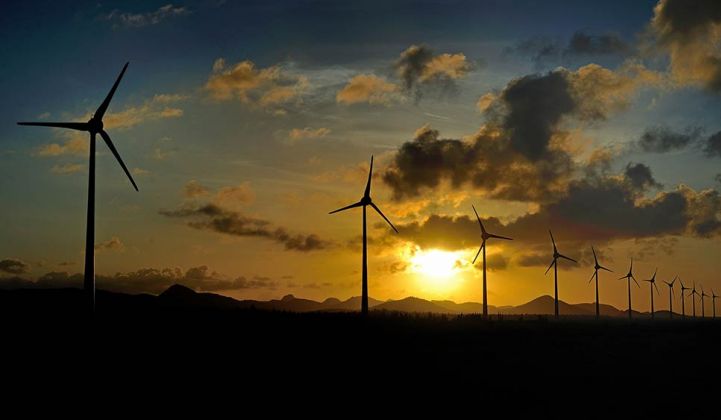In the span of just a few years, the focus at the annual Caribbean Electric Utility Services Corporation conference has shifted from issues around producing electricity from thermal capacity — usually oil — to what blend of renewable options constitutes the best path forward.
It is not just a theoretical question for the future, says Risto Paldanius, director of business development for Wärtsilä’s Energy Storage and Optimization business unit, a longtime attendee of the conference.
“It has clearly shifted, and now that the [levelized cost of energy, or LCOE] for renewables is on par or lower than any thermal generation, it’s all about solar and wind,” said Paldanius. “Then the questions become how to achieve the 100 percent renewable future everyone is talking about without causing disturbances in the grid and effectively managing solar ramp rates and generation optimization.”
They are not questions rooted only in environmental sustainability; they also address life-saving resiliency, as seen with storms that have battered communities and their power grids on many islands with devastating outcomes in the past two years, including in Puerto Rico, the Bahamas and Anguilla.
Beyond pilot projects
Paldanius doesn’t have to speak in the abstract about how to achieve high levels of renewable penetration on island grids. He can point to the experience of the Caribbean island of Bonaire, which has deployed a mixture of battery energy storage, wind and thermal engines controlled by Greensmith’s Energy Management System (GEMS).
Earlier this year, Greensmith Energy, a Wärtsilä company, worked with Contour Global — the island’s sole power producer — to reimagine the island’s grid to incorporate more renewable generation.
“In the Caribbean, especially on the small islands, the effects of climate change are [obvious to] everybody,” said Giorgio Narminio, Caribbean assets chief operating officer for Contour Global, during a recent GTM webinar, A 100% Renewable Energy Future Is Possible With Intelligent EMS Technology.
The desire to transition to more renewables also had to be balanced with grid stability. “The challenge is to combine sustainability, reliability and affordability at same time,” said Narminio.
The island had previously relied on generation from 14 megawatts of heavy fuel engines, 3 megawatts of diesel backup engines, a small lead-acid battery system, and 11 megawatts of wind generation to meet the annual demand of 110,000 megawatt-hours. In March, Wärtsilä deployed a 6-megawatt/6-megawatt-hour lithium-ion battery storage system along with GEMS to control all of the Contour Global’s generation assets.
Forecasting with precision
One of Contour Global’s main objectives was to reduce wind curtailment and optimize spinning reserves provided by the engines and frequency and voltage regulation to balance the intermittent renewable power.
Contour Global was able to sharpen its forecasting and dispatch optimization capabilities with the new software, which leverages machine learning and artificial intelligence.
“In Bonaire, we can forecast load based on historic data. We look at it along with real-time data to come up with a forecast every five minutes for the next 48 hours,” said Paldanius. “We have very high accuracy for the load forecasts for the next 12 hours, and more than 90 percent for the next 12 hours after that.”
Wärtsilä expects that accuracy to improve even further as GEMS analyzes more data and tweaks its algorithms to pick up on more nuanced and less predictable load changes.
Equally important is GEMS’ prediction of the renewable generation available to meet electricity demand. On Bonaire, that means forecasting the wind resource available over the next 48 hours. As with load forecasts, projections of wind generation take place every five minutes and take into account a mix of weather data from global and local providers. Historic and weather prediction data is then combined with real-time wind meter readings from turbines on the island.
The load and generation forecasts also feed directly into how GEMS dispatches assets. The software is designed to dispatch the assets in a way that delivers the lowest-cost electricity while maintaining the island grid’s reliability.
To do that, GEMS takes into account operational constraints of the different assets, including the minimum runtime and ramp rates for the engines, the long-term economic impact of cycling the battery storage system, and how much backup power is needed. GEMS evaluates the optimal dispatch needed to achieve the lowest LCOE every five minutes.
“GEMS has real-time frequency and voltage controls that operate on a millisecond timeframe,” said Paldanius.
Islands leading the way
Since being installed last March, GEMS has been able to deliver significant benefits to Bonaire. Wind curtailment has been reduced significantly, and today wind provides as much as 33 percent of the island’s energy. In addition, engine fuel consumption has been reduced by 5 percent and carbon emissions are down 8 percent.
Narminio says that Contour now has plans to add a solar PV plant to the island’s grid in early 2020. The result will be days when the island runs on 100 percent renewable energy.
“When you have a high wind season, we can surely have days when we have 100 percent renewable penetration because we can have the PV, we can have the wind, and we can have the battery and the inverter keeping the grid stable,” he said. “Therefore, we can easily stop all of the thermal machines.”
The same 100 percent renewable targets are also achievable on much larger grids. What it requires are sophisticated energy management systems like GEMS and market rules that incentivize battery storage paired with renewable resources. “I think you’ll see things like day-ahead dispatchable solar plants now that we have advanced forecasting,” said Paldanius.
“We have the tools to do this already. It’s now about policies and market products. When it comes to reaching 100 percent, the islands will show us the way.”

